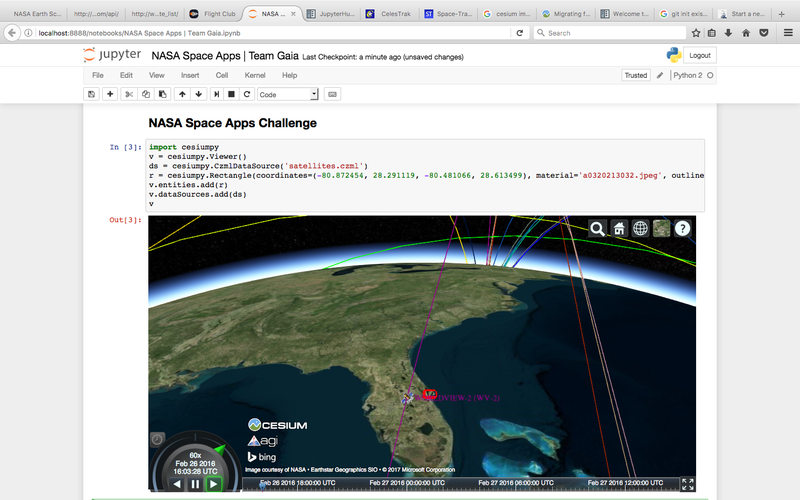Gaia | 1D, 2D, 3D– Go!
The Challenge | 1D, 2D, 3D– Go!
Reproducible Research With Cesium and Jupyter Notebooks
Recycling Value through Reproducible Research using Web Based Tools and Standards

Collaborative Planning for Reproducible Research.
In an effort to Improves communication between mission designers and decision makers Team Gaia has assembled a set of technologies to take raw research and output 3D graphics for interactive mission simulations all in a web based application.
Mission designer are able to create a Interactive simulations that include 3D models of celestial bodies, spacecraft, and orbital trajectories that run within a web-browser.
Project Details:
Our project is really a set of standards for utilizing a web based environment for reproducible research that can be output in 3D visualization through Cesium inline with the author's research and analysis.
By having a Documentation, Data Sources, Analysis, and the Data Model all living together in one place on the web... This project offers advantages over traditional research and communication tools and systems.
For our solution in particular:
Our project included data sources from current Two Line Elements (TLE) for current satellite positioning information (https://www.celestrak.com/NORAD/elements/) to near real time scientific data distribution sets (https://storm.pps.eosdis.nasa.gov/storm/) to static Vector Feature sets of launch site facilities. These datasets exemplify the standard data sets from web feature services (WFS) and web map services (WMS) as well as homegrown CSV files commonly used in any data workflow.
Our team offered a set of standards on the following:
- Jupyter Notebooks - Link: http://jupyter.org/about.html , https://github.com/jupyter/notebook
- Cesium 3D Visual - Link: https://cesiumjs.org/
- CesiumPY - Link: http://cesiumpy.readthedocs.io/en/latest/
Visualizations can play data-files generated from sophisticated orbital dynamics analysis applications through use of Python code to interact with the inline Cesium visualiser.
Our solution Provides opportunities to build agency-wide multi-disciplinary teams around Notebooks that can be viewed and run in any web browser. These Noteoboks can be developed using standard Python data science knowledge and processes.
These Notebooks and be hosted privately or be shared publicly which will engage and educate the public about future space missions as well as create an easily manageable pipeline for civilian space research and review.
Tutorials for Use:
Primary: http://cesiumpy.readthedocs.io/en/latest/examples....
Future Development:
Looking Forward, we envision concerns with new tool suite adoption. To improve "adoptability" we envision the following continued development:
-- Wrapping up categories of API calls in standardized python functionality
-- Creation of error checking tools for debugging spatial and temporal consistency of disparate datasets
-- Development of a usable FAQ
We also would like to propose a set of style standards to help NASA formalize the implementation of these tools.
Inspiration for the proposed style guide for this project:
Publishing NASA scientific and technical information: https://www.sti.nasa.gov/publish-sti/#.WQYqzYjyu00
Official NASA Publications Guide for Authors: https://ntrs.nasa.gov/archive/nasa/casi.ntrs.nasa....
Our Project available on Github:
https://github.com/mlgraham/nasa-space-apps-2017/
SpaceApps is a NASA incubator innovation program.